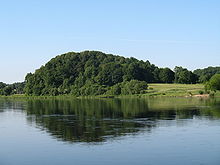54°51′43″N 23°55′34″E / 54.86194°N 23.92611°E / 54.86194; 23.92611
For the hill in Israel, also known as Napoleon's hill, see Tel Gerisa.You can help expand this article with text translated from the corresponding article in Lithuanian. (March 2023) Click for important translation instructions.
|



Napoleon's hill, actually Jiesia (Pajesys) hill fort mound is located in Kaunas, Lithuania, on the left bank of the Nemunas, between the Panemunė and Railway bridges. It is 63.3 meters high. Since the 19th century, it has been named Napoleon's hill.
From this hill Napoleon Bonaparte watched his Grande Armée crossing the Neman during the French invasion of Russia on 24/25 June 1812; according to his orders two bridges were built to the left of the Jiesia and one in front of the hill, each 300 m apart.
According to the memoirs of contemporaries, on 23 June 1812. Napoleon Bonaparte arrived at the Nemunas River, near Panemunė, where the 6th Polish cavalry regiment was stationed. Wearing a colonel's "surtout" and hat, the commander reconnoitred the river from Panemunė to Aleksotas. The Grand Army Bridge Construction Unit was led by General Jean-Baptiste Eblé. He was ordered to build three bridges across the Nemunas, 300 metres apart. Two of them were to be built between the Panemunė and the Jiesia river, and one to the left of the river, opposite the hill from which the Emperor chose to command the crossing. At 10 p.m., the operation to cross the Nemunas began.
See also
References
- Correspondance de Napoléon Ier: 12 novembre 1811-30 juin 1812, p. 622
- Philippe Paul comte de Segur (1842) HISTOIRE DE NAPOLEON ET DE LA GRANDE ARMEE PENDANT L'ANNEE 1812, p. 126
- Lithuanian Military Digest (2020) NO 7 (26), p. 14-23.
- Nawrot Dariusz, Didžioji Armija Kaune ir jo apylinkėse 1812 m. birželį //Kauno istorijos metraštis 13 T., Kaunas, 2013, p. 73-74
Sources
- "Napoleono kalnas" (in Lithuanian). Retrieved 2009-05-09.
- https://keturiossostines.lt/en/objektas/jiesios-piliakalnis-su-gyvenviete-vadinamas-napoleono-kalnu